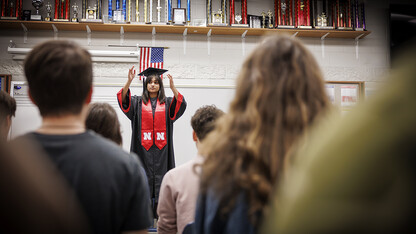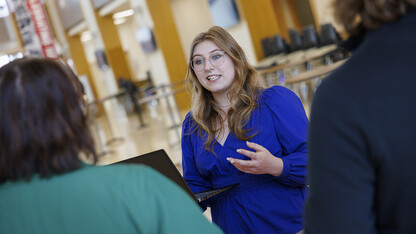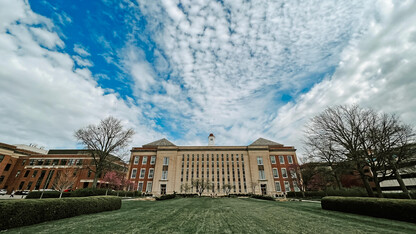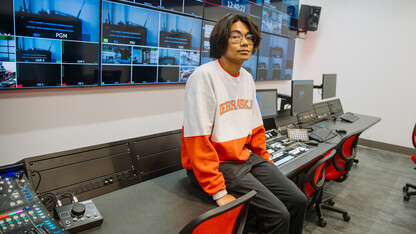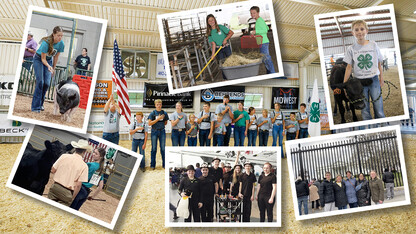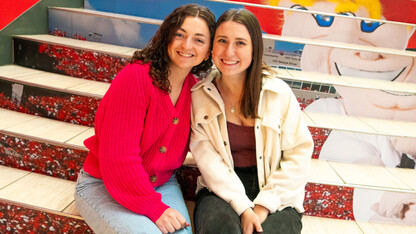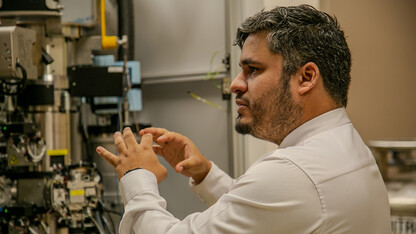· 10 min read
Nebraska in the national news: January 2020

University of Nebraska–Lincoln faculty members shared their expertise on Iran and fermented foods with prominent media outlets in January. The stories were among 35-plus featuring Husker faculty, staff, students, centers and programs during the month.
Rupal Mehta, assistant professor of political science, was interviewed for a Jan. 4 New York Times article on the United States’ drone-strike assassination of Maj. Gen. Qassim Suleimani, Iran’s top military leader, and what it might mean for the Middle East. Mehta said the strike could send a message to the surviving members of Suleimani’s network. But when the U.S. has killed high-ranking members of terrorist organizations, she said, their replacements have tended to be more extreme not less.
Mehta also participated in a live interview on the topic Jan. 6 on BBC Radio’s “Up All Night.” (The interview begins at 2:35:05.) She said she thought it was too early to tell whether the assassination would impact Iran’s nuclear ambitions or whether the killing strengthened or weakened Tehran.
“From what we’ve been able to gather, both from intelligence sources and from the ripple effects — including U.S. troops being asked to leave Iraq, the suspension of U.S. coalition against ISIS forces and a relatively robust response from the Iranian population in support of the Iranian government — this has potentially strengthened Iran …,” she said.
Robert Hutkins, Khem Shahani Professor of Food Science, was interviewed for a Jan. 8 Washington Post article on fermented foods being trendy but not necessarily probiotics. He said that most microbes — including fungi and bacteria — in fermented foods have not been characterized or defined, let alone tested in clinical trials to see if they offer probiotic health benefits.
However, fermented foods offer plenty of other benefits. Fermentation helps preserve food by suppressing microbes that might make people sick. Cheese and yogurt are among the best sources of calcium in the human diet, Hutkins said, and fermented vegetables such as kimchi and sauerkraut contain B vitamins and vitamin C.
Even when there are no live microbes left in a finished food, Hutkins said, dead microbes can still boost the food’s nutritional value — such is the case with sourdough bread. Fermentation also enhances the digestibility of some foods.
“For example, lactose-intolerant individuals can consume yogurt, even though it contains lactose, because the yogurt microbes provide the lactase enzyme needed to digest that lactose,” Hutkins said. “Lactose-intolerant individuals can usually also consume aged cheese, because the lactose is removed during fermentation.”
More coverage:
Matt Spangler, animal science, wrote a recent column offering advice for bull sale season. The High Plains Journal and Western Livestock Journal ran the column.
Chigozie Obioma’s second novel, “An Orchestra of Minorities,” was named a top-20 book to read in 2020 by E! News on Jan. 3. Obioma is an assistant professor of English at Nebraska.
A 2017 study by Bruce Johnson, emeritus professor of agricultural economics at Nebraska, and Anil Giri, assistant professor of agribusiness management at the University of Central Missouri, was cited in a Jan. 6 Rapid City Journal article on retail sales in South Dakota. The study showed that a town’s population is the biggest factor affecting retail draw.
New research by Melanie Trenhaile-Granneman, animal science graduate student, suggests that sows undergo changes in structure over time. Farm Journal’s Pork magazine highlighted the research in a Jan. 7 article.
Justin “Gus” Hurwitz, law, testified Jan. 8 during a U.S. House Energy and Commerce subcommittee hearing on “dark patterns” — or deceptive internet practices. He suggested that the Federal Trade Commission could have untapped abilities to address misinformation that harms consumers. “If we already have an agency that has power, let’s see what it’s capable of,” he said. CNET published a Jan. 8 article on the hearing.
Amy Schmidt, biological systems engineering, has developed a program called the iAMResponsible Project, aimed at educating consumers, agricultural producers and others on the risks associated with antimicrobial resistance and strategies to mitigate those risks. Scientia published a Jan. 8 article on the program.
Dana Fritz, art, was interviewed about her photo series “Views Removed” for a Jan. 8 Lenscratch article.
A team of researchers from the U.S. Department of Agriculture’s Meat Animal Research Center in Clay Center and the University of Nebraska-Lincoln have identified two major genes associated with bovine congestive heart failure in beef feedlot cattle. The study is the first to confirm genetic risk factors associated with BCHF. A Business Wire story on the research appeared in more than 120 media outlets. Brian Vander Ley, assistant professor and veterinary epidemiologist at Nebraska, and co-principal investigator on the project, was interviewed for the story.
Xiao Cheng Zeng, chemistry, and colleagues at Peking University have discovered surprising quirks in Nebraska Ice’s normally hexagonal configuration. Physics World published a Jan. 14 article on the research.
Dave Annis, dining director at the university, was interviewed for a Jan. 15 Food Management article on food-service operators struggling to find labor to fill open positions. He said he now has 40% more students working for him than he did 10 years ago because they each work fewer hours.
Stephen Baenziger, agronomy and horticulture, has been awarded a research grant from the Brewers Association — a not-for-profit trade association dedicated to small and independent American brewers. Baenziger’s project is titled “Building a Winter Malting Barley Market for the Great Plains.” A GlobeNewswire story on the association’s 2020 grant recipients appeared in about a dozen media outlets.
Peter Sutter, electrical and computer engineering; Eli Sutter, mechanical and materials engineering; and colleagues have developed a nano-engineering technique that could aid in the exploration and scalability of next-gen electronics. Technology.org ran a Jan. 16 article on the research.
John Wunder, emeritus professor of history, was interviewed for a Jan. 17 NBCNews.com article on a new monument in Albuquerque, New Mexico, commemorating a 19th century landmark civil rights case that allowed Chinese individuals to testify in an American court for the first time. Wunder is the author of the book “Gold Mountain Turned to Dust: Essays on the Legal History of the Chinese in the Nineteenth-Century American West,” which details the case.
Peter Wagner, Earth and atmospheric sciences and biological sciences, was quoted in a Jan. 18 Nature article on a new supercomputer analysis of Earth’s fossil record. The analysis shows a clearer history of life during the early Palaeozoic era, allowing researchers to pinpoint the rise and fall of species during diversifications and mass extinctions to within about 26,000 years. Wagner was not involved in the work, but wrote an essay accompanying the study.
Frans von der Dunk, space law, was interviewed for a Jan. 18 Civilized article on whether people can legally smoke cannabis on the moon. He said the legality would depend on the origin of the spacecraft. “Space isn’t part of any country, but there is a concept … that allows states to exercise control over registered spaceships, which almost qualify as a floating territory of the flag state,” he said.
Von der Dunk was also the featured guest on the Jan. 29 episode of the Spacewalks, Money Talks podcast. He discussed his work and the current state of space law.
The university’s Outdoor Adventure Center is now offering hunting equipment rentals to the public. USA Today highlighted the program in its 50-states feature Jan. 20.
Nebraska Extension’s On-Farm Research Network has earned a $1.2 million On-Farm Conservation Innovation Trials grant from the U.S. Department of Agriculture’s Natural Resource Conservation Service to help corn and wheat growers across Nebraska use new technologies to more precisely apply nitrogen fertilizer to their crops. Stories on the grant appeared in the Fence Post, Growing America, High Plains Journal and Rural Radio Network.
Aaron Berger, Nebraska Extension educator, was interviewed for a Jan. 21 Beef magazine article on the cattle birthing process. He said it is a complex process. “Weather conditions, the environment the cattle are in and the disposition of the cow can all contribute or take away from the success of the event,” he said.
A new study co-authored by Kalu Osiri, international business, suggests that using Facebook at work can have a negative effect on project success, whereas LinkedIn has a positive effect. Tech Xplore published a Jan. 21 article on the research.
Bill Moos, Nebraska athletic director, and Josephine Potuto, Larson Professor of Constitutional Law and faculty athletic representative at Nebraska, discussed the dynamics between an AD and FAR for the Jan. 21 AthleticDirectorU podcast.
Matt Joeckel, Nebraska state geologist, director of the Conservation and Survey Division and senior associate director of the School of Natural Resources, was interviewed for a Jan. 22 Outdoor Enthusiast Lifestyle blog entry on the Dakota Formation. Joeckel said the formation has yielded some of the earliest fossil flowers and fructifications from angiosperms.
A recent study by Husker political scientists was cited in a Jan. 23 USA Today opinion piece about engaging in tough conversations. According to the study, nearly 40% of Americans said politics had caused them stress, while one in five reported that a friendship had been damaged as a result of a political argument. The study was authored by Kevin Smith and John Hibbing, both political science, and Matthew Hibbing, associate professor of political science at the University of California, Merced.
The study was also cited in a Jan. 23 Men’s Health article titled “How to stay sane in a crazy election year.” According to the study, about one in five people reported doing or saying something they regretted as a result of feelings related to politics; another 20% said politics had negatively affected their relationships with friends and family.
Researchers from the University of Nebraska–Lincoln, Stanford University, Puerto Rico and Germany recently used record-intense X-rays to capture dynamics of isocyanide hydratase that were previously only hypothesized, a feat that could point the way to doing the same with other enzymes. Husker researchers involved with the study included Mark Wilson, Javier Seravalli and Peter Madzelan, all biochemistry; Medhanjali Dasgupta, biochemistry graduate student; David Berkowitz and Virendra Tiwari, both chemistry; and doctoral alumnus Gregory Applegate, chemistry. Technology.org ran a Jan. 23 article on the research. Technology.org ran a Jan. 23 article on the research.
Steven Barlow, special education and communication disorders; Greg Bashford, biological systems engineering; and graduate students have created a device that opens new circulatory pathways in the critical few minutes after a stroke has occurred. BTN.com published a Jan. 24 article on the new technology.
Michael Sealy, mechanical and materials engineering, is using 3D printers to develop dissolvable surgical implants. The research was mentioned in a Jan. 24 3DPrint.com article.
Preliminary research from the University of Nebraska–Lincoln suggests a connection between the spread of trees in the Great Plains and an increase in the size and frequency of large wildfires. The research was highlighted in a Jan. 27 Lawrence (Kansas) Journal-World article. Victoria Donovan, a postdoctoral research associate in agronomy and horticulture, was interviewed for the story.
Elham Tavakoli and Shayan Kaviani, graduate students in chemical and biomolecular engineering, and colleagues have developed a new approach for synthesizing organic “Legos” that can be easily connected to make new materials. Stories on the research appeared on Phys.org, Science Codex and a few other websites.
The U.S. Drought Monitor — produced jointly by the university’s National Drought Mitigation Center, the National Oceanic and Atmospheric Administration and the U.S. Department of Agriculture — was cited in a Jan. 30 Associated Press story on California’s winter snowpack being below average after a dry January. The Jan. 30 monitor showed more than 34% of California as abnormally dry, up from less than 4% a week earlier. The AP story was picked up by Bakersfield.com, the SF Gate and several other media outlets.
Faculty, administration, student and staff appearances in the national media are logged at http://newsroom.unl.edu/inthenews. If you have additions to this list, contact Sean Hagewood at shagewood2@unl.edu or 402-472-8514. If you have suggestions for national news stories, contact Leslie Reed at lreed5@unl.edu or 402-472-2059.
